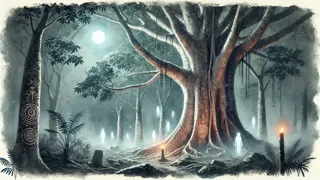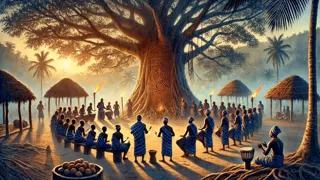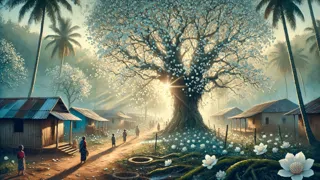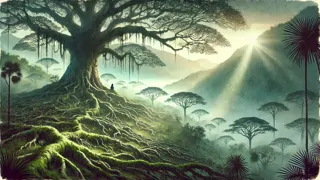Introduction
In the eastern lowland forests of Sierra Leone, long before motor echoes reached coastal villages, a single Silk-Cotton Tree rose above the misty canopy like a silent guardian. To the people of the nearby fishing hamlet, its smooth gray trunk and wide-reaching boughs carried more than shade — they harbored the voices of ancestors. At dawn, gossamer strands of cotton silk drifted down onto thatched huts, while the driftwood-strewn shoreline caught whispered songs that seemed to float upon the salt-laden ocean breeze. Local storytellers spoke of a time when spirits of ocean and forest intertwined within the tree’s hollow heart, weaving balance between land, sea, and human toil. Children, their eyes bright with wonder, pressed their palms against the living bark, convinced they could feel warm breath pulsing beneath its surface. Night brought an even deeper magic: moonlight caught on drifting silk-cotton petals, turning the clearing beneath the kapok into a ghostly cathedral of drifting white. Elders hung bundles of herbs and shells from its branches, offering prayers in chants that rose and fell like tides. When leaves rustled without wind, villagers would pause in their daily chores, listening. Every footstep seemed to echo through the network of roots that tunneled beneath homes; every creaking limb felt like an invitation to step closer to ancient secrets. This tree, called Tamba Kadieu in the Mende tongue, was no mere botanical marvel. It was a living archive of memories and dreams passed from one generation to the next, a repository of wisdom that shimmered in moonlight and glowed in dawn’s first rays. And it was within this hallowed trunk that the true Song of the Silk-Cotton Tree began to resonate — a melody of spirit, memory, and unity that would reverberate through the hearts of every villager. Many believe that the tree hears every whisper of joy, sorrow, and longing, and returns its counsel in soft murmurs no one else can hear. Fishermen swear they glimpse pale figures dancing among its roots at twilight, luminous and fleeting. Every cotton bloom that drifts away is said to carry a fragment of spirit-song toward the horizon, where tides may carry its meaning to lands unknown. In these moments, the boundary between mortal life and spirit realm felt thinner than silk, as if a single breath might bridge two worlds. It was under these conditions of awe and reverence that our story truly begins.
Whispers in the Bark
Night had settled over Ngeleya like a velvet cloak, and the softened glow of oil lanterns danced against the walls of clay huts. Kabila, whose name meant “flower of the dawn,” crept quietly toward the giant kapok that stood at the forest edge. The branches of the Silk-Cotton Tree swayed gently even though no breeze stirred among its leaves. At its base, roots the size of barrels twisted through the earth and disappeared beneath layers of fallen petals. Kabila knelt, cupped a single white silk-cotton bloom in her hand, and marveled at its feather-light texture. A distant call of a fishing canoe drifted down from the coast, carried by the tide’s hush. She raised the bloom to her cheek, inhaling a scent of salt, earth, and old magic. Behind her, the village lay silent, trusting the tree’s guardianship until dawn’s first light. Suddenly, a breath of wind rustled through the branches, but there was no wind anywhere else. In that sudden hush, a soft melody wound around her ears—a tune neither bird nor insect could produce. The song felt ancient as stone, weaving together notes of laughter, tears, and longing. Heart racing, Kabila felt the slow rise of wonder and fear in her chest. Each syllable rolled around her mind like ripples on a lagoon, tinted with salt and earth. In that moment, the forest itself seemed to inhale, as though pausing to listen. Kabila’s heart pounded so loud that she feared it might drown out the silent singing. Her fingers tightened around the fragile bloom as the melody tangled with the beating of her pulse. She leaned forward, pressing her palm flat against the trunk where the bark bulged into a hollow. A gentle vibration thrummed beneath her hand, warm as a living thing breathing quietly in slumber. It whispered one word in her mind: Labora, meaning “listen” in the tongue of ancestors. The syllable echoed through her spirit, stirring images of distant rainclouds gathering on the horizon. For a moment, the flame in her lantern flickered and dimmed, as if afraid to interrupt. Shadows slid across the clearing, and within their folds she thought she saw shapes flicker like fire. Pale outlines of ancestors brushed against the bark, moving with silent purpose between roots. Fear washed over her, yet she could not tear away, as though invisible threads bound her to the tree. Kabila closed her eyes and allowed the melody to fill her bones, learning its ancient rhythm. When she opened them again, the hush had deepened, and the song faded into a final, hushed note. The air stung with anticipation, as though the forest itself held its breath. Kabila whispered, “Who speaks?” but her voice dissipated beneath the great branches.

Rites of Renewal
At dawn, villagers gathered around Tamba Kadieu, their footsteps whispering across dew-kissed earth. Mother Loma, draped in woven cloth dyed deep indigo, carried a basket of palm nuts, yams, and woven strands of cotton silk. The crowd, draped in colors reflecting the sunrise, formed a wide circle leaving a clear space beneath the ancient limbs. Drums of varying sizes began a steady heartbeat, guiding hearts and hopes upward toward the great canopy. Elder fishermen laid out their best catch on carved wooden platters, while youths offered garlands of silk-cotton petals threaded through slender sticks. The rising sun painted the bark in warm gold, revealing ancient carvings no one could fully decipher. Villagers closed their eyes and chanted in unison—their voices a living echo of the tree’s own song. Loma stepped forward, sprinkling sacred water from a conch shell around the trunk’s base. Each droplet sang as it touched the earth, hissing softly in gratitude. She placed her palm against the trunk, offering a silent prayer in the old tongue. The breeze picked up, tugging at woven cloth and tossing drifting petals into the air. For a moment, time stilled—branches ceased their sway, birds hushed their calls, and even the drifting smoke from torches hovered unmoving. Then, from deep within the wood, a low note resonated, humming like a distant drum. The melody rose in complexity, weaving between drums and voices, answering every prayer. Tears filled many eyes, for in that unified song, the boundary between human and spirit vanished. Offers of fish, fruit, and fiber settled among roots as though the tree itself received them with patient grace. When the song finally ebbed, a gentle warmth spread through the clearing, promising renewal.

Harmony Restored
Weeks passed and the earth responded with gentle rains that fell in measured rhythm. Lush greenery returned to parched fields, and swollen rice paddies shimmered with vitality under the sun. Kabila wandered the village paths lined with drifting white blossoms, each petal seeming to hum with a faint echo of that first whispered song. Families gathered to weave new cloth dyed in the hues of dawn, offering strips to hang from the kapok’s lowest branches. Storytellers sat by crackling fires at night, passing on the tale of Labora, the voice of ancestors that spoke from within the tree. In whispered tones and joyous laughter, they taught every child to listen for the murmur beneath bark and leaf. Even traveling traders paused at the clearing, leaving small tokens: carved shells, iron trinkets, and wooden talismans tied with silk threads. Some came seeking tangible blessings—ease in harvest or safety at sea—yet left with something more profound: an abiding sense of connection. The line between human desire and spirit harmony blurred under Tamba Kadieu’s watchful limbs. No longer simply a sacred relic, the Silk-Cotton Tree had become the village’s living heart, pulsing with shared memory and promise. Villagers worked side by side, weaving nets, repairing huts, and sharing meals under its shade as though bound by an unspoken pledge. Each dawn, they listened—not with ears alone, but with hearts attuned to the tree’s soft symphony. In that daily communion, silence became as sacred as song, teaching that balance often rests in listening as much as speaking. The kapok’s petals drifted still, a constant reminder that life and spirit are intertwined in every breath and every offering.

Conclusion
In the soft glow of evening torches, the villagers of Ngeleya would often pause at the kapok’s wide trunk, placing a gentle hand against its living heart. Time marched on—children grew into adults, elders passed into memory, and the world beyond the forest edge shifted with changing tides. Yet the Song of the Silk-Cotton Tree endured, carried on drifting petals and whispered prayers beneath every harvest moon. Each offering laid at the roots—corn silk, woven cloth, seashell, and carved talisman—spoke of devotion that neither time nor hardship could erode. The melody of ancestors, once heard faintly in a single murmured word, now wove itself into daily life: guiding fishermen to gentle currents, blessing fields with timely rain, and inviting quiet reflection at dawn. Even in moments of sorrow or doubt, villagers knew that Tamba Kadieu listened, cradling their joys and fears alike within its vast embrace. Across seasonal cycles of bloom and rest, the relationship between people and spirit held firm, reminding them that true harmony demands both humble offering and open heart. And so, for generations to come, the kapok’s song would rise—soft as silk, deep as roots, and eternal as the stars that glimmer through its lofty branches.

















